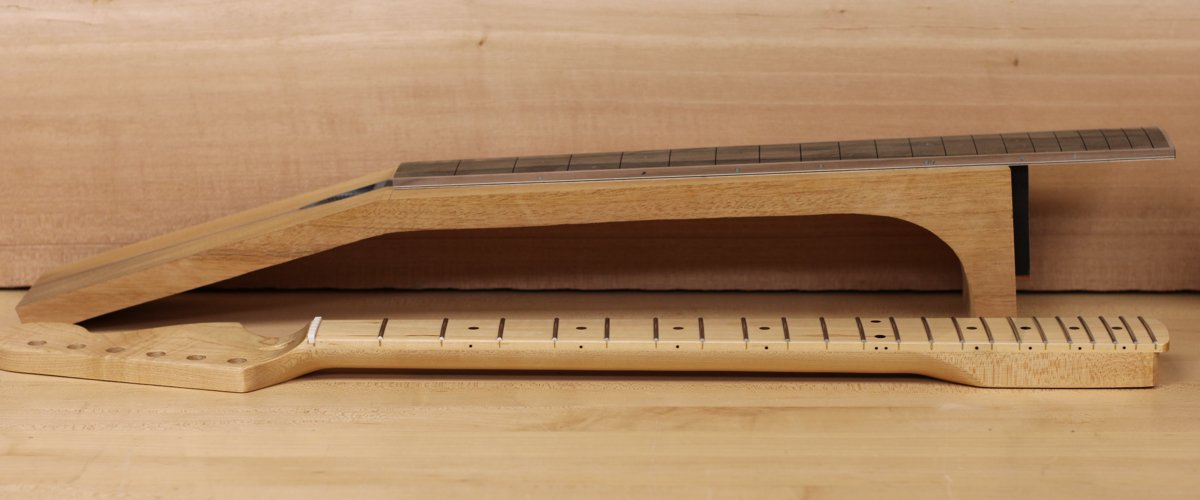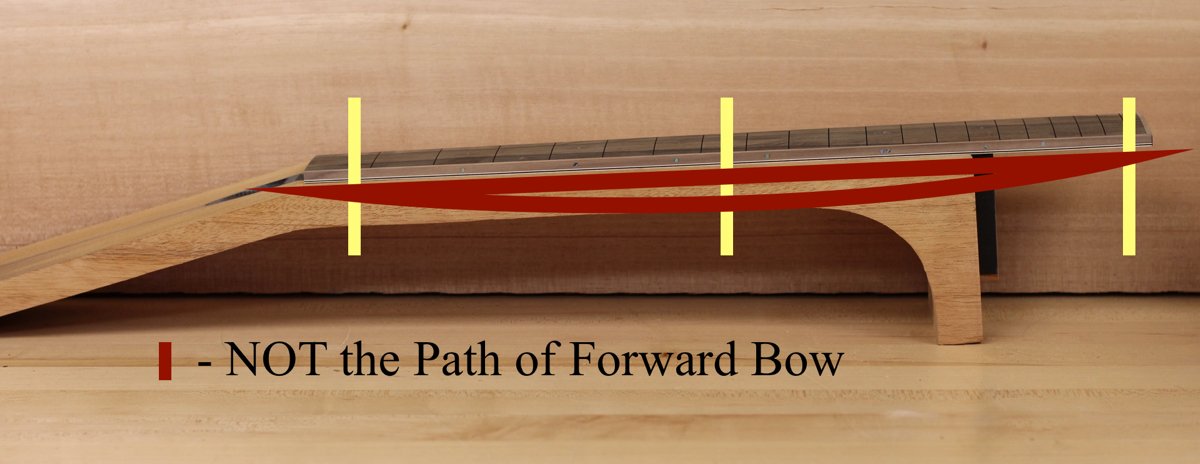These are three fretboard-related topics that I have been asked about and answered enough times, I thought they might just warrant a dedicated post (and I happen to have some photos handy). I'll begin with some definitions:
Relief describes a deliberately induced (or permitted) forward neck bow, in an attempt to mitigate inadvertent string to fret contact ("buzz").
Fall-away describes the deliberate sloping of the fretboard extension away from the path of the oscillating strings. This is usually adrressed during initial construction and/or a refret, where the surface of the board can be planed or sanded directly.
The Hump describes what appears to be a raised area in the fretboard where the neck joins the body.
Most of the time, the "Hump" isn't a hump at all, but a bit of an optical illusion that I will explain, below. Undue concern over the hump is often due to a misunderstanding of acoustic guitar neck design, including the factors of string path, relief and fallaway.
Acoustic guitar necks differ from electric guitar necks in a most significant way. A (typical) electric guitar neck supports the fretboard along its entirety, whereas a (typical) acoustic guitar neck only supports the fretboard up to the point where the neck joins the body.
The unsupported section of the fretboard of an acoustic guitar is called the fretboard extension, as it extends out beyond the neck (except in the case of an elevated fretboard, but that is a topic for another discussion).

On an acoustic guitar, forward neck bow is limited to the area between the nut and the heel (where the neck joins the body), typically concentrated at the 5th fret (for 12-fret necks) or the 6th fret (for 14-fret necks).

The pull of the strings on the headstock typically moves it up and away from its resting position when no strings are attached. The fretboard is compressed and the back of the neck is stretched as the neck curves between the nut and the heel. It is common to use a truss rod to attempt to counter the forward bow.
It is important to note that the curve produced by the pull of the strings is not occurring between the nut and the end of the fretboard. As a result, the fretboard extension, that area of the fretboard from the body joint to the soundhole, is unaffected by truss rod adjustment.

If you are convinced that relief is required on your fretboard, your target numbers should be 0.1 mm (for low relief) to 0.5 mm (considered high relief). More gap than this is (should be) unnecessary.
The extension of the fretboard that projects out beyond the neck lays on top of the hollow body of the guitar. It is a mistake to expect the surface of an acoustic guitar fretboard to be a perfectly flat plane from nut to the end of the board. Why is that? A deliberate design decision called "fall-away" is introduced to the fretboard extension, where it is sloped (slightly) to drop away from the path of the oscillating strings from the 14th/15th fret to the end of the board. What is the purpose of fall-away? To mitigate string buzz, just like introducing relief to the fretboard between the nut and the heel. Is this fall-away absolutely necessary? It depends on how low your action is, and how aggressively you pluck the strings.
It is worth stating this yet again: any forward bow in the fretboard is occurring between the nut and the neck heel. The fretboard returns to flat at the body joint, and then falls away toward the soundhole. If your fretboard has high relief and/or steep fall-away, this will account for the illusion of a "hump" in the fretboard at the body joint. If you reduce the forward bow as well as the fallaway to no more than 0.5 mm (0.02”), the so-called hump will usually disappear.
On a 14-fret acoustic guitar, setting a precision straightedge across the top of the fretboard (or the top of the frets), you would/should see a small gap at the 6th fret, no gap at the 14th fret, and a small gap again at the 20th fret.
There are some things that can exaggerate the appearance of a hump. Adding (or being unable to counter) a ridiculous amount of forward bow will introduce an obnoxious "wave" into the fretboard. Additionally, when an acoustic guitar neck is reset, the angle of incidence is most always increased. The fretboard extension must be shimmed to compliment the change in geometry, and the fall-away must be corrected (increased) so that the board does not protrude up into the oscillating string path. Simply "bending" the extension back down to be glued to the soundboard will really exaggerate the fall-away, and this repair misstep will surely produce "the hump."
Relief describes a deliberately induced (or permitted) forward neck bow, in an attempt to mitigate inadvertent string to fret contact ("buzz").
Fall-away describes the deliberate sloping of the fretboard extension away from the path of the oscillating strings. This is usually adrressed during initial construction and/or a refret, where the surface of the board can be planed or sanded directly.
The Hump describes what appears to be a raised area in the fretboard where the neck joins the body.
Most of the time, the "Hump" isn't a hump at all, but a bit of an optical illusion that I will explain, below. Undue concern over the hump is often due to a misunderstanding of acoustic guitar neck design, including the factors of string path, relief and fallaway.
Acoustic guitar necks differ from electric guitar necks in a most significant way. A (typical) electric guitar neck supports the fretboard along its entirety, whereas a (typical) acoustic guitar neck only supports the fretboard up to the point where the neck joins the body.
The unsupported section of the fretboard of an acoustic guitar is called the fretboard extension, as it extends out beyond the neck (except in the case of an elevated fretboard, but that is a topic for another discussion).

On an acoustic guitar, forward neck bow is limited to the area between the nut and the heel (where the neck joins the body), typically concentrated at the 5th fret (for 12-fret necks) or the 6th fret (for 14-fret necks).

The pull of the strings on the headstock typically moves it up and away from its resting position when no strings are attached. The fretboard is compressed and the back of the neck is stretched as the neck curves between the nut and the heel. It is common to use a truss rod to attempt to counter the forward bow.
It is important to note that the curve produced by the pull of the strings is not occurring between the nut and the end of the fretboard. As a result, the fretboard extension, that area of the fretboard from the body joint to the soundhole, is unaffected by truss rod adjustment.

If you are convinced that relief is required on your fretboard, your target numbers should be 0.1 mm (for low relief) to 0.5 mm (considered high relief). More gap than this is (should be) unnecessary.
The extension of the fretboard that projects out beyond the neck lays on top of the hollow body of the guitar. It is a mistake to expect the surface of an acoustic guitar fretboard to be a perfectly flat plane from nut to the end of the board. Why is that? A deliberate design decision called "fall-away" is introduced to the fretboard extension, where it is sloped (slightly) to drop away from the path of the oscillating strings from the 14th/15th fret to the end of the board. What is the purpose of fall-away? To mitigate string buzz, just like introducing relief to the fretboard between the nut and the heel. Is this fall-away absolutely necessary? It depends on how low your action is, and how aggressively you pluck the strings.
It is worth stating this yet again: any forward bow in the fretboard is occurring between the nut and the neck heel. The fretboard returns to flat at the body joint, and then falls away toward the soundhole. If your fretboard has high relief and/or steep fall-away, this will account for the illusion of a "hump" in the fretboard at the body joint. If you reduce the forward bow as well as the fallaway to no more than 0.5 mm (0.02”), the so-called hump will usually disappear.
On a 14-fret acoustic guitar, setting a precision straightedge across the top of the fretboard (or the top of the frets), you would/should see a small gap at the 6th fret, no gap at the 14th fret, and a small gap again at the 20th fret.
There are some things that can exaggerate the appearance of a hump. Adding (or being unable to counter) a ridiculous amount of forward bow will introduce an obnoxious "wave" into the fretboard. Additionally, when an acoustic guitar neck is reset, the angle of incidence is most always increased. The fretboard extension must be shimmed to compliment the change in geometry, and the fall-away must be corrected (increased) so that the board does not protrude up into the oscillating string path. Simply "bending" the extension back down to be glued to the soundboard will really exaggerate the fall-away, and this repair misstep will surely produce "the hump."
Last edited: